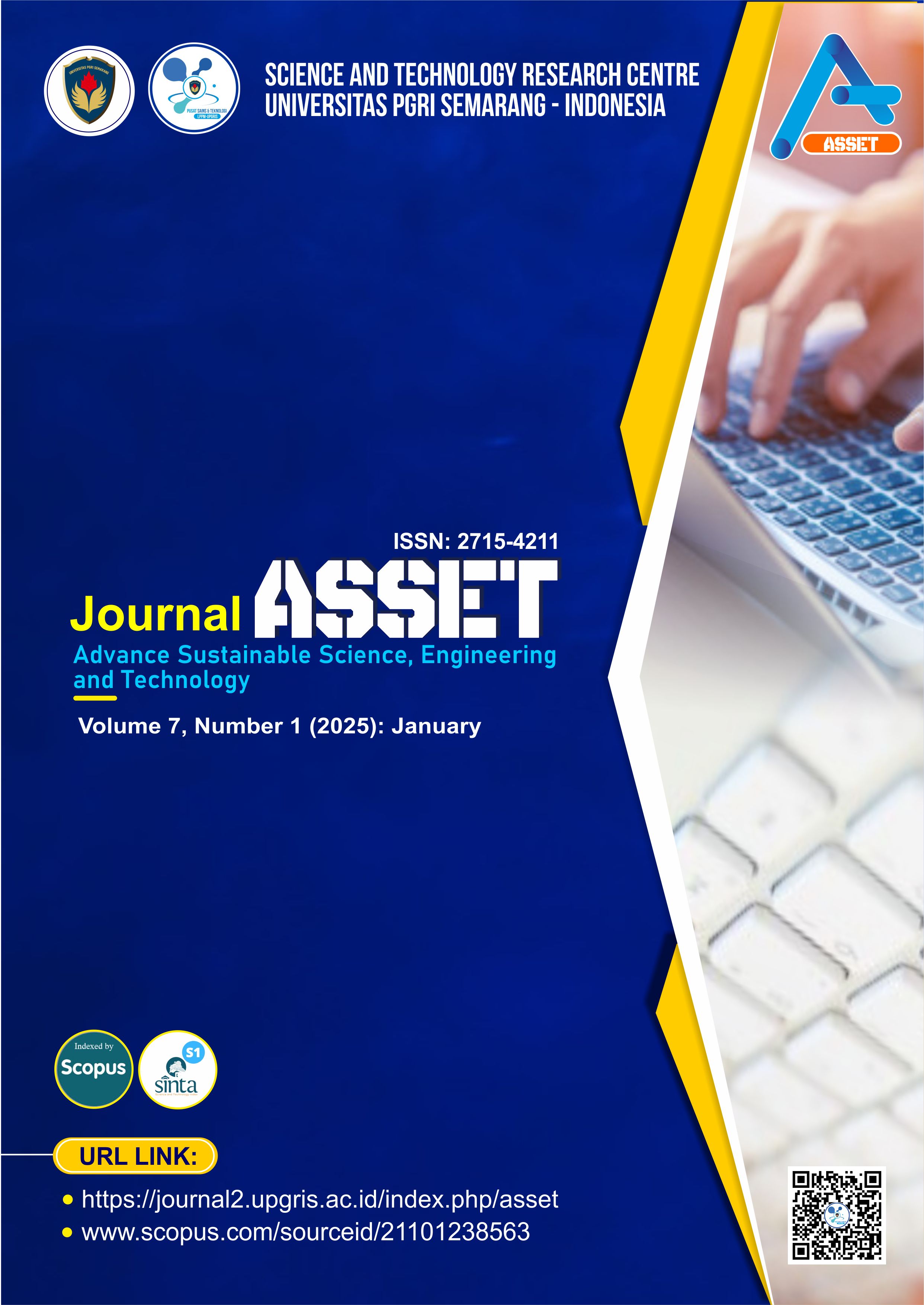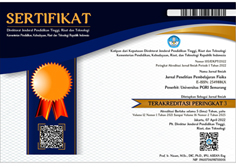Optimizing Inventory Control Using Min-Max Method for Sustainable Manufacturing Process
DOI:
https://doi.org/10.26877/asset.v7i1.1337Keywords:
Inventory Control Systems, Inventory Optimization, Production Sustainability, Raw Material Management, Supply Chain ManagementAbstract
Inventory plays an important role in a company's production process, especially in the sustainable manufacturing industry. The inventory of raw materials such as rayon, polyester, and cotton is an essential element that needs to be controlled to maintain a smooth production process. This research aims to plan and control raw materials through the min-max method, with a focus on evaluating inventory control to identify and overcome existing problems in the raw material warehouse at a yarn and textile manufacturing company. The results show that each type of raw material has a different reorder level, which guides the company in avoiding the risk of shortage or excess stock. By applying the right reorder level, the company can improve its production efficiency and inventory management. This research contributes to the practice of inventory control in the sustainable manufacturing industry, which supports operational stability and minimizes resource wastage. The implications of the findings could expand the application of min-max method-based inventory control in other industries to support operational sustainability.
References
[1] C. F. Angelina, F. T. D. Atmaji and B. Santosa, “Spare Part Requirement and Inventory Policy for Rovema’s 1 Machine Using Reliability Centered Spare (RCS) and Min-Max Stock Methods,” in 3rd International Conference on Engineering Technology for Sustainable Development (ICET4SD), 2020.
[2] B. Dai, H. Chen, Y. Li, Y. Zhang, X. Wang and Y. Deng, “Inventory Replenishment Planning in A Distribution System with Safety Stock Policy and Minimum and Maximum Joint Replenishment Quantity Constraints,” in International Conference on Industrial Engineering and Systems Management, 2019.
[3] B. Dai, H. Chen, Y. Li, Y. Zhang, X. Wang and Y. Deng, “Optimization of (S, S) inventory policies in a distribution system with minimum and maximum joint replenishment quantity constraints,” in International Conference on Computers and Industrial Engineering, 2018.
[4] N. Hernandoko and P. W. Laksono, “Inventory Control Using ABC Classification and Min-Max Stock Method in The Manufacture of Armored Vehicle Body Hull at PT XYZ,” in 8th International Conference on Industrial, Mechanical, Electrical and Chemical Engineering (ICIMECE), 2023.
[5] K. K. Chikaputri, G. A. Yudhistira and Qurtubi, “Comparison Analysis of Economic Order Quantity (EOQ) Method and Min-Max Method on Inventory Management,” in The 4th Tarumanagara International Conference of the Applications of Technology and Engineering (TICATE), 2023.
[6] L. Bertazzi, A. Bosco and D. Laganà, “Min–Max Exact and Heuristic Policies for A Two-Echelon Supply Chain with Inventory and Transportation Procurement Decisions,” Transportation Research Part E : Logistics and Transportation Review, vol. 93, pp. 57-70, 2016.
[7] S. Wang and Y. Chen, “Consumption Coupons, Consumption Probability and Inventory Optimization: An Improved Minimum-Cost Maximum-Flow Approach,” Sustainability, vol. 14, no. 13, pp. 1-14, 2022.
[8] A. T. Rahman and D. Widyaningrum, “Analysis of Inventory Control of Perishable Goods with Capital Constraints and Warehouse Capacity Using the Lagrange EOQ Method (Case Study UD. XYZ),” Advance Sustainable Science, Engineering and Technology (ASSET), vol. 5, no. 3, pp. 1-11, 2023.
[9] H. A. Aditya, M. Nuruddin and Y. P. Negoro, “Analysis of Chemical Inventory Control in the GGCP Unit Using Forecasting and EOQ Methods at PT. XYZ,” Advance Sustainable Science, Engineering and Technology (ASSET), vol. 5, no. 3, pp. 1-10, 2023.
[10] M. H. Utami, Qurtubi, D. Setiawan and M. F. N. Maghfiroh, “Control of ABC Pen Production Raw Materials Using the Material Requirement Planning to Minimize Inventory,” Advance Sustainable Science, Engineering and Technology (ASSET), vol. 6, no. 4, pp. 1-9, 2024.
[11] I. Asana, M. Radhitya, K. Widiartha, P. Santika and I. Wiguna, “Inventory Control Using ABC and Min-Max Analysis on Retail Management Information System,” in International Conference on Innovation In Research, 2020.
[12] G. I. García-Chávez, V. d. R. Carmelo-Mendieta, M. F. Collao-Díaz and J. C. Quiroz-Flores, “Inventory Management Model Based on Demand Forecasting, 5S, BPM and Max-Min to Improve Turnover in Commercial Enterprises,” in Congreso Internacional de Innovación y Tendencias en Ingeniería (CONIITI), 2022.
[13] A. L. Maukar, I. Widaningsih and P. Putra Andreas, “Probabilistic Periodic Review System to Determine Minimum and Maximum Inventory Replenishment Levels in acme company,” ARPN Journal of Engineering and Applied Sciences, vol. 11, no. 7, pp. 4295-4304, 2016.
[14] H. Zhu, “A Simple Heuristic Policy for Stochastic Inventory Systems with Both Minimum and Maximum Order Quantity Requirements,” Annals of Operations Research, vol. 309, no. 1, p. 347–363, 2022.
[15] R. Fariza, Qurtubi. and M. F. N. Maghfiroh, “Comparison Analysis of Min-Max Method with EOQ Method in Controlling NPK Fertilizer Raw Material Supply,” in 1st International Conference on Logistics (ICL), 2024.
[16] S. H. R. Pasandideh, S. T. A. Niaki and A. H. Niknamfar, “Lexicographic Max–Min Approach for An Integrated Vendor-Managed Inventory Problem,” Knowledge-Based Systems, vol. 59, pp. 58-65, 2014.
[17] Y. Zhang and H.-W. Chen, “A Min-Max Policy for Multi-Item Joint Inventory Replenishment Problem: Application to Industrial Vending Machines,” Computers and Industrial Engineering, vol. 172, 2022.
[18] F. Blanchini and R. Pesenti, “Min–Max Control of Uncertain Multi-Inventory Systems with Multiplicative Uncertainties,” IEEE Transactions Automatic Control, vol. 46, no. 6, pp. 955-960, 2001.
[19] J. Xiao, Y. Kang and S. Kong, “Optimization Model of Inventory and Transportation Under Maximum and Minimum Delivery Cycle,” Liaoning Gongcheng Jishu Daxue Xuebao (Ziran Kexue Ban)/Journal of Liaoning Technical University (Natural Science Edition), vol. 32, no. 3, pp. 393-396, 2013.
[20] T. Wang, Y. Chen and Y. Feng, “On the Time-Window Fulfillment Rate in A Single-Item Min-Max Inventory Control System,” IIE Transactions (Institute of Industrial Engineers), vol. 37, no. 7, pp. 667-680, 2005.
[21] B. Dai, H. Chen, Y. Li, Y. Zhang, X. Wang and Y. Deng, “Inventory Replenishment Planning of a Distribution System with Warehouses at the Locations of Producers and Minimum and Maximum Joint Replenishment Quantity Constraints,” in 8th International Conference on Operations Research and Enterprise Systems, 2019.
[22] M. Charles, S. Dauzere-Peres, S. Kedad-Sidhoum and I. Mazhoud, “Motivations and Analysis of the Capacitated Lot-Sizing Problem with Setup Times and Minimum and Maximum Ending Inventories,” European Journal of Operational Research, vol. 302, no. 1, pp. 203-220, 2022.
[23] A. H. Niknamfar, S. A. A. Niaki and M. Karimin, “A Series-Parallel Inventory-Redundancy Green Allocation System Using A Max-Min Approach via the Interior Point Method,” Assembly Automation, vol. 38, no. 3, pp. 323-335, 2018.
[24] S. Shekh, “Min/Max Inventory Planning for Military Logistics,” in 21st International Congress on Modelling and Simulation, 2015.
[25] W. Ni, J. Shu and M. Song, “Location and Emergency Inventory Pre-Positioning for Disaster Response Operations: Min-Max Robust Model and a Case Study of Yushu Earthquake,” Production and Operations Management, vol. 27, no. 1, pp. 160-183, 2018.











